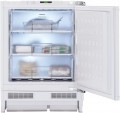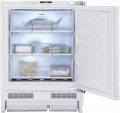Minimum temperature
The lowest temperature that the freezer can maintain in normal operation. First of all, the duration of food storage in the freezer depends on this parameter: it is believed that a temperature of -12 ° C is enough to preserve food for a month, -18 ° C – 3 months, -24 ° C – up to a year. At the same time, it must be taken into account that not only temperature affects the shelf life but also the type of product and its quality before freezing.
Freeze capacity
One of the main indicators of freezer performance is the approximate amount of fresh food that the freezer can completely freeze from room temperature to the minimum operating temperature in 24 hours. For domestic use, a power of 10-15 kg/day is considered quite sufficient. More performant models may be required if you have to freeze a lot of food at a time or for industrial purposes.
Energy class
The energy class shows how economical the freezer is in terms of electricity consumption. Initially, the classes were designated in Latin letters from A (most economical) to G (high power consumption). Recently, improved classes A+, A++ and A+++ appeared (the more pluses - the more economical the device).
It should be borne in mind that this indicator represents not the actual energy consumption but the efficiency of the unit compared to similar models. Therefore, a small class A freezer may have a lower power consumption than a large class A++ model. And other things being equal, a more economical device, as a rule, costs more, but this difference can quickly pay off during the operation.
Energy consumption per year
It is the average amount of energy consumed by the freezer in a year of operation. Of course, these figures are not absolutely accurate. The actual power consumption may vary depending on the specific operating conditions. However, this parameter makes it possible to evaluate the consumption of the device and compare different models with each other. At the same time, it often turns out to be more convenient and visual than the energy consumption class (see above) because, in this paragraph, we are talking about a specific figure (from which you can also calculate the cost of electricity consumed).
Climate class
The climate class to which the freezer corresponds.
As the name implies, this parameter describes the environmental conditions for which the unit is designed. The warmer it is around, the more powerful the freezer should be and the better thermal insulation it should have. Specific classes are indicated by letters. Here are the most popular options:
— SN (subnormal). Models for a cool temperate climate have an operating range from +10 °C to + 32 °C. Such a unit can be useful in a poorly heated room where the temperature can drop below +16 °C — for example, on the veranda of a private house, in a garage, etc.
— N (normal). Freezer for a temperate climate, with an operating temperature range of +16...+32 °C. Such a unit is suitable for most residential apartments and houses in mid-latitudes.
— ST (subtropical). Models for subtropical and humid tropical climates. Normally they work at the range of external temperatures +18...+38 °C.
— T (tropical). Refrigerators for dry tropical climates. Designed for temperature range +18 °C to +43 °C.
Also, note that there are many models on the market with an extended temperature range covering several classes. For example, a unit labelled N-ST will have a temperature range of +16...+38 °C. These freezers are indispensable in climates, conditions which are not covered by one standard class — for example, in cold winters and hot summers.
Noise level
The average noise level generated by the freezer during operation. The quietest models give out about 25 - 30 dB — this is the average noise background in a residential area at night (comparable to the ticking of a wall clock); the loudest — is about 60 dB (loud conversation). More detailed comparison tables can be found in special sources.
In any case, the lower the noise level, the more comfortable the use of the unit. However, it does not always make sense to look for the
quietest freezer: in some situations (for example, in a noisy workshop), the freezer's sound may be lost against the surrounding noise background. In addition, reduced noise often affects the price.
Door panel hinge
—
Sliding hinget. A sliding hinge involves the connection of a decorative panel with a freezer door using movable guides. So, with the sliding hinge, the front decorative facade is equipped with its hinges, and the freezer door is practically not loaded by the panel. On the other hand, with this type of hinge, there is a small gap between the decorative panel and the freezer door, in which dust can accumulate. Additionally, the sliding hinge does not allow the freezer door to be opened more than 90-95˚.
—
Fixed hinge. With a fixed hinge, the panel is hung on the freezer door. It is the easiest and fastest option for installing the decorative panel. The fixed hinge assumes that the decorative panel loads the door hinges of the freezer. When choosing the fixed hinge for the panel, it should be taken into account that if the door of the freezer is not sufficiently reliable, the door of the built-in unit may be overloaded. Most often, the fixed hinge of the panel is used when installing a relatively small freezer. The compact panel is unlikely to overload the freezer door.
Country of origin
It is the country in which, according to the manufacturer, this or that model is manufactured. Even though most of the capacities are concentrated in China, European factories for the production of household appliances have not disappeared. And some models can be produced there. In general, such a division into a Chinese or European factory should not particularly affect the quality of products, but the stereotype of a reliable European assembly is present. However, it is possible that the model may have a country of manufacture, for example, Poland, and in the store under the same article, you will meet China.

